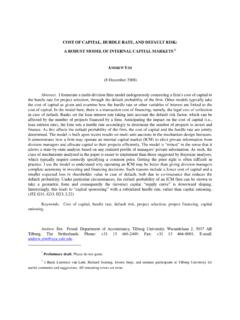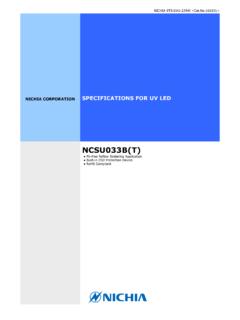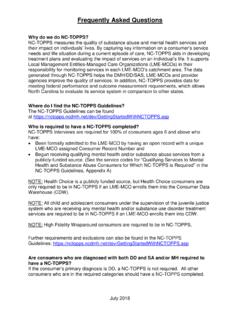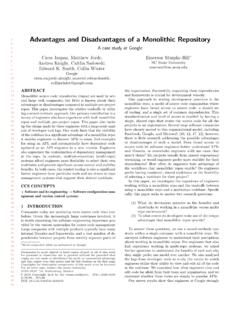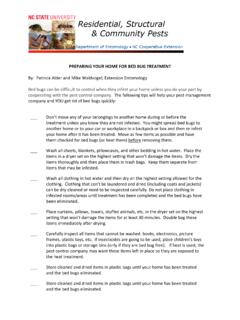Transcription of Enterprise Risk Management For Financial Institutions
1 Enterprise Risk Management For Financial Institutions Rating Criteria And Best Practices GOVERNANCE. Policies Risk Tolerance Conflict of Interests Disclosure STRATEGIC/BUSINESS. Competition Product Innovation Management Incentives MARKET. Trading ALM. Investing CREDIT. Underwriting Counterparty Portfolio Management OPERATIONAL. Compliance Legal Reputation Audit Fraud Accounting Fiduciary Back Office Standard & Poor's Technology 55 Water Street New York, NY 10041 Personnel Enterprise Risk Management For Financial Institutions : Rating Criteria And Best Practices November 2005.
2 Published by Standard & Poor's, a Division of The McGraw-Hill Companies, Inc. Executive offices: 1221 Avenue of the Americas, New York, NY 10020. Editorial offices: 55 Water Street, New York, NY 10041. Subscriber services: (1) 212-438-7280. Copyright 2005 by The McGraw-Hill Companies, Inc. Reproduction in whole or in part prohibited except by permission. All rights reserved. Information has been obtained by Standard & Poor's from sources believed to be reliable. However, because of the possibility of human or mechanical error by our sources, Standard & Poor's or others, Standard & Poor's does not guaran- tee the accuracy, adequacy, or completeness of any information and is not responsible for any errors or omissions or the result obtained from the use of such information.
3 Ratings are statements of opinion, not statements of fact or recommendations to buy, hold, or sell any securities. Standard & Poor's uses billing and contact data collected from subscribers for billing and order fulfillment purposes, and occasionally to inform subscribers about products or services from Standard & Poor's, our parent, The McGraw-Hill Companies, and reputable third parties that may be of interest to them. All subscriber billing and contact data collected is stored in a secure database in the and access is limited to authorized persons.
4 If you would prefer not to have your information used as outlined in this notice, if you wish to review your information for accuracy, or for more information on our privacy prac- tices, please call us at (1) 212-438-7280 or write us at: For more information about The McGraw-Hill Companies Privacy Policy please visit Analytic services provided by Standard & Poor's Ratings Services ( Ratings Services ) are the result of separate activities designed to preserve the independence and objectivity of ratings opinions.
5 The credit ratings and observations contained herein are solely statements of opinion and not statements of fact or recommendations to purchase, hold, or sell any securities or make any other investment decisions. Accordingly, any user of the information contained herein should not rely on any credit rating or other opinion contained herein in making any investment decision. Ratings are based on informa- tion received by Ratings Services. Other divisions of Standard & Poor's may have information that is not available to Ratings Services.
6 Standard & Poor's has established policies and procedures to maintain the confidentiality of non-public information received during the ratings process. Ratings Services receives compensation for its ratings. Such compensation is normally paid either by the issuers of such securities or third parties participating in marketing the securities. While Standard &. Poor's reserves the right to disseminate the rating, it receives no payment for doing so, except for subscriptions to its publications. Additional information about our ratings fees is available at Permissions: To reprint, translate, or quote Standard & Poor's publications, contact: Client Services, 55 Water Street, New York, NY 10041; (1) 212-438-9823; or by e-mail to: Letter To Readers Standard & Poor's Ratings Services is pleased to present Enterprise Risk Management For Financial Institutions : Rating Criteria And Best Practices.
7 This guide presents the latest ratings criteria for assessing the trading risk Management practices of Financial Institutions , as well as a broad look at current best practices within Financial Institutions with respect to Enterprise Risk Management . The industry faces greater challenges in assessing risks within this dynamic and evolving market structure. Regulatory and accounting practices are rapidly alter- ing their code of requirements to best practices. The principles of best prac- tices of risk Management are not viewed that differently around the world.
8 There is, for example, a common language, as evidenced by Basel II (SOX, IAS, and more recently the SEC as well), which is essentially an attempt to codify some of those principles and link them into regulatory practices and capital assessment. The extent to which banks have adopted best practices in managing risk is a key benchmark in Standard & Poor's ERM initiative. Our approach focuses on the effectiveness of policies, infrastructure, and methodologies (PIM) for controlling risks . Historically, most serious losses in trading operations could be traced to generally not one but a series of weaknesses in policies, infrastructure, and methodologies.
9 Our aim, then, is to evaluate the robustness of the risk control practices. In focusing on PIM, we are essentially focusing on the governance of the trading floor risk Management function, its consistency with corporate strate- gies and risk appetite, and the way in which Management assures itself that it has the methodologies and infrastructure in place to monitor and control the risks it undertakes. To be effective and to add value, the risk assessment process must be approached from an Enterprise -wide perspective because the risk assessment process is subject to the same evolutionary dynamics as the risk measuring and monitoring aspects.
10 By adding discipline and analytical rigor to the process of assessing the risks of Financial Institutions , Standard & Poor's reaffirms its ongo- ing commitment to providing leadership and guidance to the market during times of significant change. Jayan Dhru Managing Director & Head of North American Financial Institutions Group Standard & Poor's | Enterprise Risk Management For Financial Institutions | November 2005 3. Table of Contents The PIM Approach To Assessing The TRM Practices Of Financial Institutions 7.
